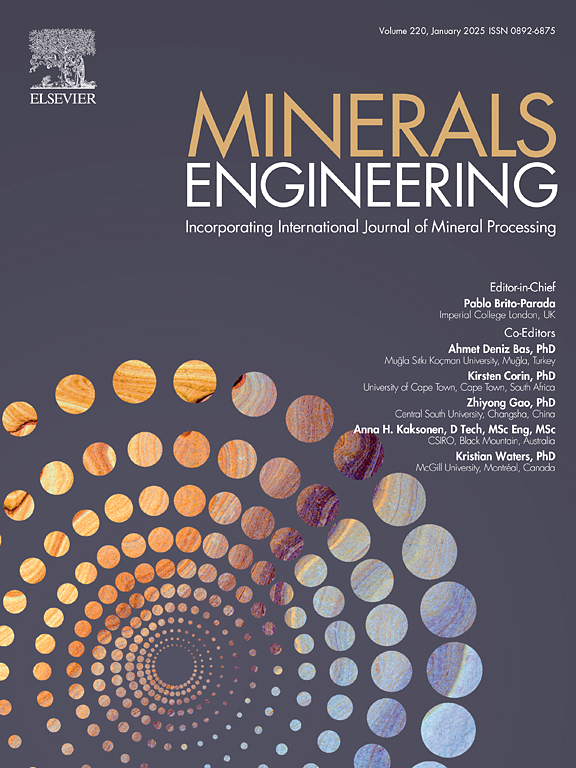Recovery of niobium and tantalum from tin slags: An alternative approach using acid roasting and oxalic leaching
IF 4.9
2区 工程技术
Q1 ENGINEERING, CHEMICAL
引用次数: 0
Abstract
An alternative approach for extracting Nb and Ta was investigated, based on the acid roasting of tin slags using the KHSO4-H2SO4 system, followed by oxalic leaching. Roasting experiments demonstrated the formation of soluble sulfated products, optimized through thermodynamic modeling: mineral grain size fraction −75 µm, Slag-KHSO4-H2SO4 ratio 1:0.5:0.5 (g:g:ml), roasting temperature 300 °C, and roasting time 2 h. Under these conditions, the material conversion rate was maximized, characterized by mineralogical and morphological analyses that showed the chemical changes occurring during roasting helped explain the mechanisms at work during the process. After optimizing the treatment parameters by varying process conditions, it was found that approximately 94 % of Nb and 75 % of Ta were dissolved during the oxalic leaching stage, under the following conditions: concentration 0.5 mol L−1, S/L ratio 50 g L−1, reaction temperature 60 °C for 60 min. Consequently, this innovative alternative could reduce reagent and energy consumption, promoting a sustainable approach with a lower environmental footprint.
从锡渣中回收铌和钽:酸焙烧和草酸浸的替代方法
采用硫酸氢钾体系对锡渣进行酸焙烧,然后进行草酸浸出,研究了一种提取铌和钽的替代方法。焙烧实验表明,可溶硫酸盐产物的形成,通过热力学模型优化:矿物粒度- 75µm,矿渣- khso4 - h2so4比1:0. 5:5 .5 (g:g:ml),焙烧温度300℃,焙烧时间2 h。在此条件下,物料转化率最大,通过矿物学和形态学分析表明,焙烧过程中发生的化学变化有助于解释该过程的作用机理。通过不同的工艺条件对处理参数进行优化,发现在浓度0.5 mol L−1,S/L比50 g L−1,反应温度60℃,反应60 min的条件下,草酸浸出阶段约有94%的Nb和75%的Ta被溶解。因此,这种创新的替代方案可以减少试剂和能源消耗,促进可持续的低环境足迹的方法。
本文章由计算机程序翻译,如有差异,请以英文原文为准。
求助全文
约1分钟内获得全文
求助全文
来源期刊

Minerals Engineering
工程技术-工程:化工
CiteScore
8.70
自引率
18.80%
发文量
519
审稿时长
81 days
期刊介绍:
The purpose of the journal is to provide for the rapid publication of topical papers featuring the latest developments in the allied fields of mineral processing and extractive metallurgy. Its wide ranging coverage of research and practical (operating) topics includes physical separation methods, such as comminution, flotation concentration and dewatering, chemical methods such as bio-, hydro-, and electro-metallurgy, analytical techniques, process control, simulation and instrumentation, and mineralogical aspects of processing. Environmental issues, particularly those pertaining to sustainable development, will also be strongly covered.
 求助内容:
求助内容: 应助结果提醒方式:
应助结果提醒方式:


